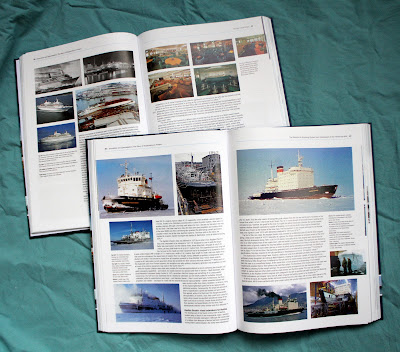To celebrate the 500th entry of this blog, today I will be doing something different. People have occasionally asked me for a guide to ship photo locations in Helsinki, and I thought making one would be a nice way to commemorate the milestone. When compiling these, I quickly realised there are simply too many photo spots in the city to include in one entry. So, today we will be looking at the photo spots in Suomenlinna and the surrounding islands (which are probably the most photogenic of the lot), which will allow you to photographs ships sailing to and from Eteläsatama (South Harbour), as well as icebreakers passing to their quays in Katajanokka, and the few remaining ships sailing to Sompasaari harbour (which is currently under redevelopment into a residential area).
The other photo spots for Eteläsatama (yes, there are more!) and those for Länsisatama (West Harbour) will have their own entries later on, if and when I will have the time and energy to write them.
Ship photo locations in Suomenlinna, Lonna and Vallisaari
 |
| The photo locations in and around Suomenlinna that I have used; see smaller map below for the precise locations at Kustaanmiekka (numbers 5-9). Satellite picture courtesy of Google. |
|
Suomenlinna, Lonna and Vallisaari offer diverse views, and as the islands are located on different sides of the shipping lane, these give you a wide variety of options depending on the time of day and lighting conditions.
Lonna
1: Lonna is a small military island opened to the public a couple of years back. It's biggest advantage is the location just south of the main shipping lane out of the South Harbour, which passes the island in a roughly from west to east. Thus, whereas from most Suomenlinna locations (2-10) the side of the ship facing the camera will in the shade until circa 14.00-15.00 in the afternoon - and from Vallisaari (11-13) you will have the opposite problem - from Lonna you can get photos pretty much as long as it's light out. The ideal photo spot is a small quay on the north shore of the island.
Lonna is accessible by JT Line's ferries from Kauppatori (Market Square), with the crossing taking approximately seven minutes. The ferry only runs between May and August. Because the place is essentially deserted before this, barnacle geese and seagulls nest here in large numbers. If you visit early in the summer, move with care as both can be aggressive - and make sure you have enough time, so you can peacefully pass all the nests. The ferry quay is on the south side of the island, so there are potentially quite a few birds on the way.
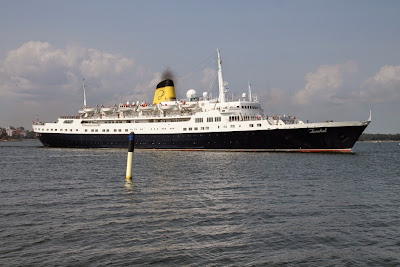 |
| As the main shipping lane passes quite close to Lonna, you get quite impressive views. Cruise ships at the Katajanokka cruise quay sometimes use the more northernly shipping lane, but this also gives decent views. The full set of the Funchal can be seen here. |
Suomenlinna
Most Suomenlinna locations are only usable in the afternoon, after circa 14.00-15.00, due to the fact the main shipping lane passes from the east side of the island in roughly north-south direction. Note that parts of the island are a low-security prison and therefore not accessible to the public. Suomenlinna is accessibly by HSL (Helsinki Regional Transport Authority) ferry from Kauppatori around the year, JT Line ferry from Kauppatori between May and September, and JT Line ferry from Hakaniemi between June and August.
2: Suomenlinna guest harbour breakwater serves essentially the same function as Lonna, allowing views of the east-west shipping lane north of the islands. As Lonna allows superior views, this is really only a good spot during the time of the year when Lonna is not accessible.
 |
| The island in front of the ship is Lonna, so obviously you are shooting from much further away. The full set of the Ocean Countess can be seen here. |
3: This random hill on the "wrong" side of the island offers great views of the ships approaching the Kustaanmiekka strait, with Suomenlinna itself in the foreground. The window for photos without obstructions in the foreground for front-views of departing ships is fairly narrow, but the forward views of arriving ships are quite great. Of course, there aren't too many evening arrivals...
For as long as I can remember, there has been a "do not enter - landscaping in progress" sign attached to a low rope fence around the hill, but there is nothing to stop you from climbing on top.
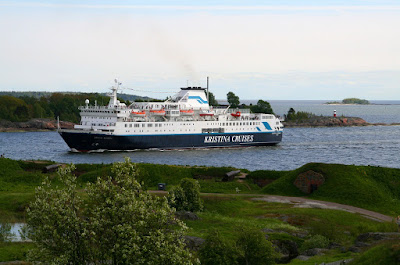 |
| The best views from here are definately those of afternoon and evening arrivals. The full set with the Kristina Katarina can be seen here. |
4: The beachfront north of the ramparts (discussed below) has quite often been the spot from where I've photographed when the ship has left early or when I've been delayed in getting to the prime spots. Still, there are some pretty nice views to be had. Note that the yellow building on the beach is a single-family home, so do not trespass on their yard (and maybe also don't include the residents in the photos without permission).
 |
| For aft views, this spot is not ideal, but for front views it's nice. The full set with the Empress can be seen here. |
 |
| Satellite picture courtesy of Google. |
5-9: The ramparts at Kustaanmiekka. There are multiple levels, with different ways of accessing them. The map here shows the continuous ramparts in green, accompanied by the numbers as in main map - except for number 9, which is a smaller spot and not a continuous rampart.
Note that, in most locations here, there are no safety railings and some spots are not easy to access.
5: The upper rampart is probably the place that gives the most impressive views. For best views, my recommendation is to climb atop the parapet (doable, but requires some dexterity and strength) - this also gives a chance to take aft views of departing ship without the need to move. Otherwise, you will need to be at the northern edge of 5 for the forward views, and then gallop to the southern edge for aft views. Again, doable, but the somewhat uneven ground is not ideal for running.
 |
| Yeah, this is the spot from which you take this particular shot, variations of which all of you must have seen hundreds of times now. A full set with the Minerva can be seen here. |
6: The main viewing area is a place that you will have to share with other people but you do get nice views of both front and rear, with minimal need for movement. This is also the easiest spot to access (okay, number 5 isn't hard either, but it's higher up).
 |
| This spot gets you slightly closer to the ships than number 5, so you get a bit more dynamic shots. The full set with the Black Watch can be seen here. |
7: The Kustaanmiekka beach front get you very close to the ships, albeit with a somewhat low angle. Access here is difficult: you can either walk along the waterline from the north, which will required some balancing on rocks right at the waterline, or you can climb through one of the windows under number 8 (reserve some time to find the correct one).
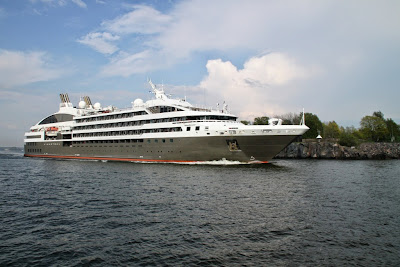 |
| Same spot as in the picture above, but with a radically different angle. The full set with L'Austral can be seen here. |
8: The rampart closest to the sea was closed to visitors a few years back, after a young child fell to their death from the rampart. You can get there by climbing over the fence in the northern edge of the rampart (visible in the photo for 6 above). Relatively many people do this, as the area was open for decades, and closing it seems strange when areas with just as potentially deadly drops are still open, with no safety fences put up either (case points, numbers 5 and 6). The photos are nice, and I have never seen anyone around to stop you from climbing over the fence - but of course, I don't recommend doing so either.
 |
| And of course, I have absolutely not gone to the area since it was closed myself. The full set with the Prinsendam can be seen here. |
9: The south rocks only give you views towards the south, so this is only useful for evening arrivals (or if you really, really want aft views). Similarly to number 7, access is by climbing through a window below number 8 ramparts. You can theoretically also walk here along the beach from the west, but if I recall correctly there is a steep climb - at least I've never used that route myself.
 |
| The Viking XPRS' evening arrival is the main use for this location. This is one of the earliest photos actually put up in this blog, and the only photo I've posted from that particular session. I think my image editing skills have improved a bit since then. |
10: The south beach is similar to number 9 in having a view only towards the south, but you can get some fairly neat shots, especially in windy weather when you get nice waves on the foreground.
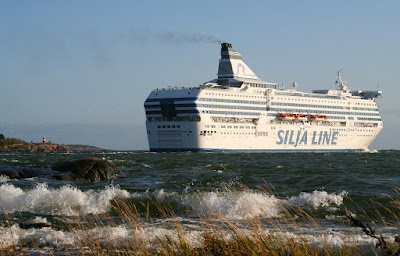 |
| Admittedly this spot is mainly good for ships you've already photographed before from both directions - but it's still a nice view. The full set with the Silja Symphony can be seen here. |
Vallisaari
As with the others, Vallisaari is a former military island, but was only opened to the public in 2016. As there local ecosystem is quite rare, and unaacounted for explosives potentially remain in the ground, you should not stray from the marked paths. Due to being on the west side of the shipping lane, Vallisaari is ideal for photographing morning arrivals and departures; the light should remain okay until circa 14.00, though I've never actually been out there so late myself.
Both JT Line and Aava Lines serve Vallisaari from Kauppatori between May and September, and JT also sails from Hakaniemi between June and August. JT Line sails to Luotsipihan laituri on the north shore, while Aava goes to Torpedolahti in the east. Both are a bit removed from the main photo spots, but a bigger problem is that the first morning departures for both companies are too late to get to photograph the morning ferry arrivals. Thus, if you want to photograph the ferry arrivals, this will set you back over 100 euros (or that was the rate the last I checked) - so the best idea would be to gather a larger group to split the bill.
11: Kustaanmiekka towards the north. I know I just said you shouldn't stray from the marked paths, but this one will require you to do so. From the main gravel path towards number 12, a small path through the grass northwest to a small concrete tower; this is the only location that I've discovered so far that has any decent view towards the north, making it ideal for morning/mid-day departures. However, you can't really get decent aft views.
 |
| The place is fairly low, but you do get nicely dynamic shots. The full set with the Viking XPRS (including shots taken at number 13) can be seen here. |
12: "Gibraltar of the North" is what this bit is called in the map of Vallisaari; it is a vieweing platform built specifically to give views over the Kustaanmiekka strait to Suomenlinna, and toward the sea in the south. Due to vegetation, the view towards the north is nonexistent (and the route between 11 and 12 is so long it's not really a workable to run from one to the other, as there's no coastal path). Resultingly, it's best for morning arrivals - but number 13 will give you much more impressive views.
 |
| Not a bad view at all. The full set with the Mariella (including shots taken at number 11) can be seen here. |
13: Aleksanterin pattery is a former artillery battery on the highest point of the island. Metal walkways have been built above the battery, and the views are really, really great. For morning arrival, I'd say this definately the best place in Helsinki, also offering the most unique views.
 |
| The southern parts of the island, visible here in the foreground, is currently completely closed to the public. The full ser with the Silja Symphony can be seen here. |






